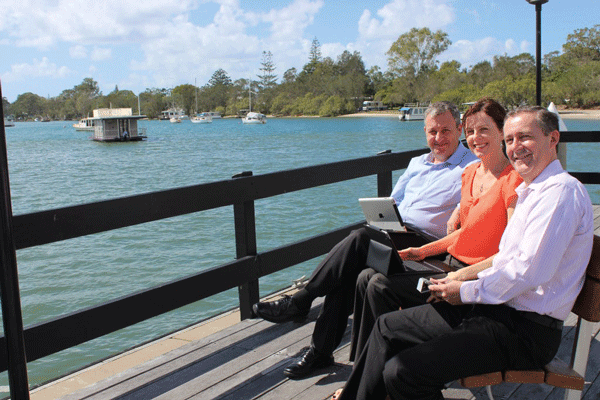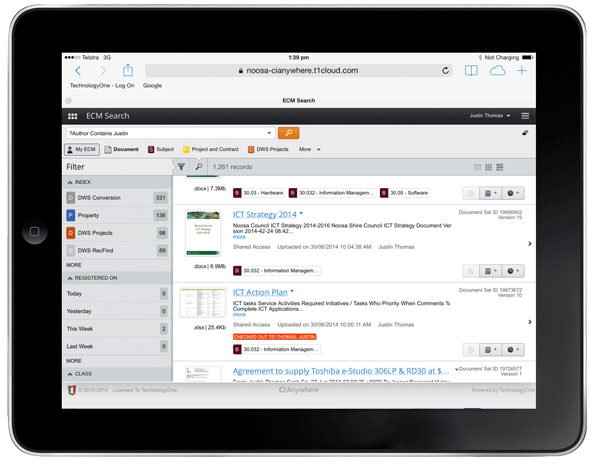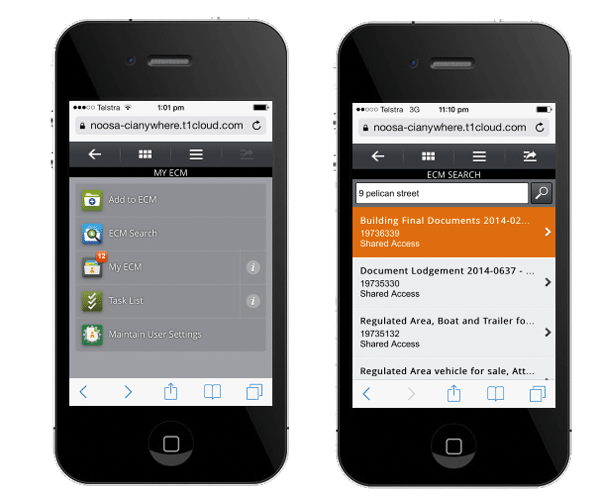Noosa takes ECM to the cloud

A cloud-first strategy for ECM and enterprise apps is paying dividends for Noosa Council.
When residents of the Queensland resort town of Noosa voted via referendum to “undo” its amalgamation into Sunshine Coast Regional Council, a tough challenge was set in place.
Having been through a major upheaval when the merger took place in 2008, the Shire was now faced with the task of beginning anew and migrating data from Sunshine Coast’s locally hosted TechnologyOne environment.
While the selection of the TechnologyOne OneCouncil suite and ECM maintained continuity for council’s corporate systems, it was decided to make a break with the past and have the entire software suite running as a managed service in the TechnologyOne Cloud, hosted on the Amazon Web Services (AWS) platform in Sydney.
The clock began ticking following the referendum in March 2013, but all was in readiness by the time Noosa Council came into existence on January 1 2014 with 420 staff (350 FTE) to provide services to the Noosa community of over 56,000 people.
The cloud-only strategy meant ICT team at the new Noosa Council is significantly smaller than the 2008 Council with the elimination of five positions including DBA, infrastructure expert and infrastructure support roles.
Noosa Council runs all important corporate computer systems from data centres in Sydney (over 1000 kilometres away) either from TechnologyOne on Amazon or Nexon Asia Pacific Infrastructure as Service.
This includes email, telephony (Microsoft Lync), GIS, disaster response, respite care systems, the waste management system and the leisure facilities management system. There is a single, outsourced IaaS physical server at Noosa that provides two virtual servers for logon authentication, printing and personal computer imaging. Noosa has Microsoft Office 2010 on the local personal computer SOE with staff able to check documents in/out of the TechnologyOne ECM hosted in Sydney.
Office 2010 was installed on desktops to allow desktop integration with Microsoft Lync and to provide more time for the Council to evaluate future use of Office 365, Google Docs or cloud based VDI (virtual desktop infrastructure).
To give staff the best experience with ECM, Noosa has deployed Google Chrome browser to PCs to overcome a file drag and drop limitation inherent with Internet Explorer.

Demonstrating the benefits of mobility (l to r) Justin Thomas, ICT Manager; Julie Ember, Solutions Architect; and Martin Drydale, Director Planning and Infrastructure (Project manager on the Noosa corporate systems project).
Noosa was the first Council in Australia to run the new Ci Anywhere 4.03 version of ECM that is delivered through a web browser interface from the Internet as Software as a Service.
It was initially hoped to restrict access to 5TB of files on network drives brought over from Sunshine Coast, and initially these were limited to read-only.
However the functionality of the browser ECM interface was not something that many users could immediately adapt to their requirements, so the transition team relented and switched the network drives back on.
“Everyone was under a lot of pressure with the tight timeframes and everything else that was going on. So we really didn’t have the business support to do that, and that’s something we have to revisit in the future,” said Justin Thomas, ICT Manager at Noosa Shire Council.
Agreeing it was a bridge too far to remove access to shared drives on day one, Solutions Architect/IT Strategist Julie Ember notes, “We had 4 months to build an IT infrastructure from scratch for a new organisation. The fact that we got all of the systems up and running and were fully operational on day one was quite amazing. But due to the short timeframe, we were forced to implement tactical solutions in some areas. So we now have to step back and develop a strategy for Document Management across the entire organisation. In effect, approach it the way we would’ve liked to have done it if we had 12 months or even 6 months.
“We obviously considered the cost of building a data centre and hosting and so on and compared it all, and then the choice of utilising cloud services ended up being a cheaper option.
“Migrating from the on-premise TechnologyOne ECM at Sunshine Coast to the early adopter browser-based version meant we lost a bit of functionality.
“So we’re now re-strategising ECM and looking at indexes and looking at how to do things differently and trying to move the organisation further into using ECM, particularly for those areas they have not traditionally “fit” into ECM in the past. But the processes have to be user friendly: if it’s not, then people aren’t going to use it and will find ways to work around the system.”
“Having all the documents in ECM searchable and available from any mobile device with an Internet browser is fantastic. I don’t have to use Dropbox or other cloud services to keep documents accessible and that is a great outcome for secure document management for the Council,” said Thomas
“One aspect of this ubiquitous mobile access is it is making us think more about what we are putting into ECM. For example, viewing Outlook MSG files put into ECM isn’t an issue when you are accessing ECM via a PC equipped with Outlook. But for a smartphone user that isn’t an attachment type that is natively accessible.”
Go-live involved the extraction of over 2.4 million ECM documents and metadata from Sunshine Coast Regional Council related to Noosa properties, customers and projects. Even though Sunshine Coast Council ran an earlier version of TechnologyOne ECM, the extract effort involved intensive database analysis work by TechnologyOne as well as transferring terabytes of ECM data to the TechnologyOne Cloud.
Noosa Council went live with ECM on the 6th January following the importation of documents and associated metadata.
Noosa inherited the indexes, work flows, and document notes from the ECM system of Sunshine Coast Council. Noosa also managed the transfer of hundreds of boxes of physical records including one hundred year old meeting minutes.
To comply with Queensland State Archives requirements documents were officially transferred by a methodology that passed custodianship to Noosa relieving the continuing Sunshine Coast Council of responsibility for the transferred records including any copies in their own ECM.
“The council has deployed some basic scanning capabilities for incoming correspondence but so far no OCR for automated workflows, instead it is working to migrate to electronic forms able to directly input data into enterprise apps.”
Staff transferred to the Noosa Council were only released to Noosa Council in mid-December, leaving little time for establishing the processes needed for the new Council. The knowledge management architectures, policies and systems of the huge regional Council were ill suited for the smaller Noosa Council. They were also ill suited for the major changes in the way CI Anywhere ECM can work with corporate applications, users and devices.
The powerful search capabilities of the new ECM means that subject indexes used previously to find documents are now only necessary to determine retention. Mobile capabilities mean that outdoor staff can be expected to use ECM.
Connected Content
TechnologyOne has integrated ECM into the OneCouncil suite via Connected Content. This automatically puts any documents created by or added to the OneCouncil suite into ECM, also adding the associated customer, property, application and subject indexes.
Where a staff member previously would have added the document to OneCouncil property record and then again into ECM against the property, the ECM process happens automatically resulting in significant time savings and less reliance on staff to be diligent with adding documents to ECM.
“ TechnologyOne Connected Content is a major business change that has required Council to look at how we can organise our ECM content to simplify subject indexes and setup quick add profiles,” said Thomas.
Quick add profiles automate the application of ECM indexes to documents and are used by Connected Content, the new email to ECM capabilities of 4.03 ECM and can be used by users when adding documents to ECM via the browser.
ECM Access has allowed Noosa to provide ECM documents related to development applications in a searchable Internet page that draws documents directly out of ECM. ECM Access also allows URLs to ECM documents to be used rather than maintaining a separate copy of a document on an Intranet or Internet site. Noosa has yet to fully exploit these capabilities as they require business change and staff education, not just the availability of the technology.
“Noosa staff are still learning the 4.03 ECM so we can better plan knowledge and records management suited to the Noosa Council scale and our new systems,” said Thomas
Being a pilot site for 4.03 Noosa has worked closely with TechnologyOne providing feedback on the product as TechnologyOne continues to refine and develop it. TechnologyOne ECM product owner Kris Brown attends the Council’s ECM user group meetings demonstrating each new release as it is installed into the Noosa test environment and previews upcoming releases in the TechnologyOne development environment. These visits engage the key ECM users at Council and provide feedback to TechnologyOne on user reception to new features and prioritisation of features.
“We consider TechnologyOne a partner that we have a working relationship with not just a contract relationship. We treat TechnologyOne staff with the same respect and care as we treat internal staff because our dependency on TechnologyOne is just as great as internal staff,” said Thomas
“TechnologyOne can resolve issues promptly without the dependency on Council in-house ICT staff for diagnosis or resolution. TechnologyOne take ownership of issues and coordinate their own application managed services, cloud infrastructure support, consulting, developer and product owner resources.
“An unexpected benefit of outsourcing application support to TechnologyOne is TechnologyOne driving innovation at Council. This is because TechnologyOne staff have a depth and breadth of experience we couldn’t match in-house and this help find where Council staff are not using systems efficiently.”
“TechnologyOne’s exposure to other Councils also drives business improvements. For example, TechnologyOne provided support for another application managed services customer and picked up that we hadn’t configured or used a module they were using to automate a process we were still performing manually."
When TechnologyOne consultants are working on implementation of new TechnologyOne modules, they are dealing with their own infrastructure and support resources.
"We find that implementations happen much faster and smoother than where there was a previously reliance on in-house infrastructure resources – there just aren’t the arguments or negotiation that would happen between consultant and in-house staff,” said Thomas.


Noosa‘s Ci Anywhere ECM can be accessed on any device with Internet access, be it a mobile phone or tablet or laptop.
